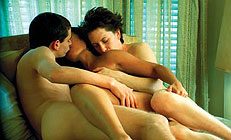|
|
|
|
Ken
Park
|
 |
|
One of the best and most important films I saw in 2003 was Ken Park by the prolific Larry Clark – his third in twelve months, after the remarkable Bully (2001) and the amusing telemovie remake of Teenage Caveman (2001) – made in collaboration with ace cinematographer Ed Lachman. This dual credit is not insignificant in terms of the film's achievement: the extraordinary sense of intimacy it creates between the camera and its subjects is due to the fact that Clark and Lachman were able to work with such a small crew. I saw the film in the context of an international Film Festival, where it created no censorship scandal. Indeed, it seems to have stirred such a fuss in no country except Australia. The sophisticated overseas audience was able to judge Ken Park in a continuum with other films that are part of what one European critic jokingly dubbed the New Pornographic Wave, an international trend that includes the Thai masterpiece Blissfully Yours (2002) and Catherine Breillatīs Sex is Comedy (2002). All these films place explicit sex scenes into extremely complex, self-reflexive contexts. Clark has always filmed groups, never individuals. Teenagers have long been his favourite subject, as in his debut feature Kids (1995). But in recent years the group interactions in his work have expanded to include a range of adults, who are variously bemused, uncomprehending, excited or intolerant in the face of what their sons and daughters get up to. In Ken Park, Clark explores a logical development of his interest: the filmīs single-minded theme is the various forms of sexual relationship between teenagers and adults. Virtually every situation in the film is one of abuse, although Clark does not shy away from the ambiguities involved in consensual sex that strays from normal, socially sanctioned paths. No one could deny that Ken Park is confronting and unsettling stuff. This is par for the course in Larry Clarkīs long and distinguished career as a photographer and filmmaker. Often decried as a voyeur, his subject is the fascinating contradiction between physical beauty – he films even the grungiest young punks as street angels – and a form of modern alienation that produces astonishingly amoral behaviour. Death – whether through disease, murder or suicide – is a grim constant in his work. Clark is often accused of peddling an old manīs grubby sexual fantasies. But there seems to me few filmmakers who are as fixed as Clark on the real-world consequences of so-called free sex in a time when there are no longer agreed-upon moral standards, and where oppression seeps into all aspects of personal life. To my eyes, Clark neither exploits his subjects, nor judges them from an Olympian distance. This is precisely what disturbs some viewers and critics – including, we must now infer, the Australian Classification Board. It is astonishing that the Board has seen fit to block screenings of Ken Park, even within the normally protected, specialist-audience space of Film Festivals. Judged purely in terms of the graphicness and the reality of events filmed, it pushes the envelope far less than Breillatīs Romance (1999) or Baise-moi (2000). Those two films deliberately set out to destabilise the artificial distinction between erotica and pornography by including hard-core moments of real penetration. In Ken Park, by contrast, all such acts are simulated. The only borderline instance in this regard is an extravagant and rather hilarious masturbation scene that leads to a nasty end for one of the characters – a deliberately exaggerated, cartoon-like spectacle. Ironically, the scene that seems to have given the Classification Board most trouble is the penultimate threesome between three teens. Prefaced by a story related by one of the youths about a primitive erotic utopia, it is one of the most beautiful and intoxicating sex scenes in cinema history – a pure celebration of pleasure, and indeed the only unproblematically happy moment in Clarkīs entire oeuvre. Perhaps the Classification Board overlooked what makes this scene so powerfully significant. It is the only key event in the film where adults are not present. MORE Clark: Marfa Girl 2 © Adrian Martin June 2003 |
![]()